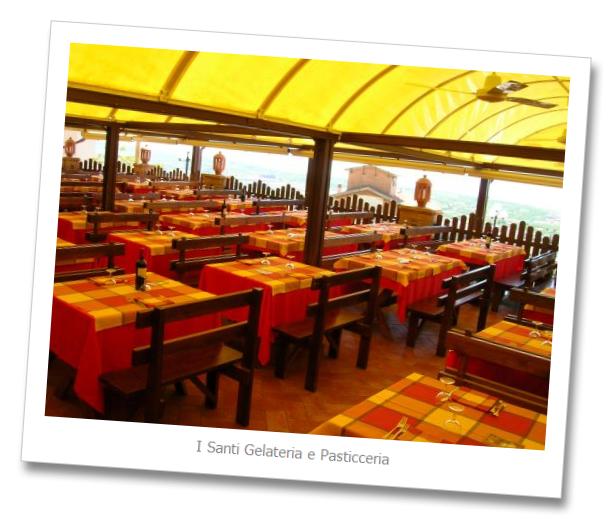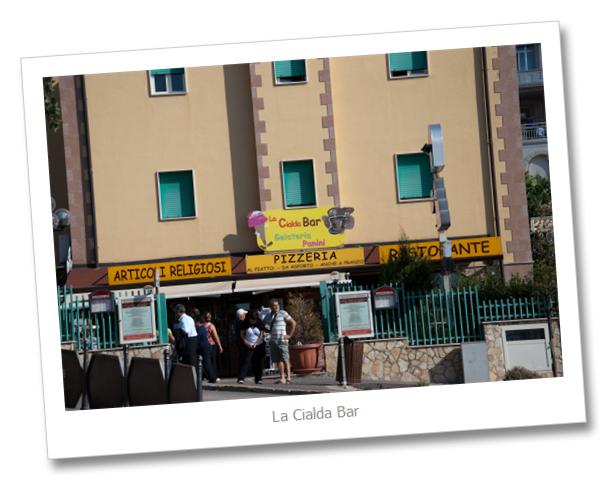PADRE PIO PLACES: Exploring San Giovanni Rotondo
The best thing about setting off to explore all the Padre Pio places in San Giovanni Rotondo is that each of them is just a few steps away from each other. Yep, you don’t have to consult your map every five minutes or so. This is the first thing I noticed because I am always, always, geographically-challenged! Take me to a mall, blindfold me, spin me around, and it will surely take me a lot of time to figure out where I am. Lol! I guess I should watch more of that Brainy Baby DVDs that help develop your brain and prepare you for things like this. Hehehe!
Ok, so back to our topic…all in all, there are five must-visit places in San Giovanni Rotondo. Each of these places has its own story to tell. If you go with a pilgrimage tour group, you usually just have half a day to visit all these…or maybe a day at most. But in my own humble opinion, you should take at least two days in this mountain to experience its wonder and the different vibe that it has. If you often wonder why a lot of people have decided to abandon their old lives and stay in this mountain for good, it would be really good to come at a time when you are giving yourself a spiritual recharge and not merely vacationing. That way, you can stay longer and experience this place fully. Their cuisine is something to enjoy as well! And mind you, this mountain is not lacking in souvenir shops. I must have spent hours going through all the nice items they have on display…hehehe!
Below is my attempt to give you a preview of the must-visit places in San Giovanni Rotondo. I have not indicated addresses because you’re not going to need them; trust me. When you get to one of these places, the others will be just a few steps away. And yeah…just follow the crowd! Padre Pio had always been a crowd drawer. Even now (year 2009), 40 years after he died, 7 million people visit his mountain every year…and the number continues to grow as the families of his faithful devotees continue to expand.
ONE: Santa Maria Delle Grazie (Our Lady of Grace Church)
This church actually started as a small one when the Capuchin friars arrived in San Giovanni Rotondo. The little church was consecrated and dedicated to Our Lady of Grace on July 5, 1676. Padre Pio celebrated Mass here from 1916 to 1959. When you get there, here are the interesting points to see:
a. The Padre’s Confessional Box
The confessional box is now enclosed in hard, transparent plastic. Maybe it’s fiberglass? I’m not really sure. When you look through the plastic wall, you’d see that a lot of devotees have tossed over their petition letters, photographs, ultrasound results, and even money. You’d know that people all over the world have set foot in that place because the notes/messages they tossed were in different languages. This is the same confessional box where in 1947, Father Karol Józef Wojtyła, a young Polish priest, came and received absolution from Padre Pio. It is also in this same confessional box where Padre Pio told Father Wojtyła that he will someday ascend to the highest post in the Church…true enough, he became our beloved Pope John Paul II.
b. The Altar
The altar has the image of Our Lady of Grace, the protector of San Giovanni Rotondo. This altar is where Padre Pio celebrated the Holy Eucharist from 1916 to 1959.
c. The Tomb
I find it unnerving that the Padre’s tomb was already built before he died. In fact, it was blessed the day before he went to heaven. The guide book I bought in one of the souvenir stores says that the Padre’s coffin is laid one meter below floor level and is protected by a three ton monolithic block. Both Pope John Paul II and Saint Theresa of Calcutta have visited the tomb and have prayed there.
d. The Padre’s Cell
Padre Pio occupied this cell from 1943 to 1968. Looking at it, you could see how humble and simple the Padre’s life was. I only saw a bed, a side table, an arm chair, a desk, a chair, a lamp, and a tiny sink. On the walls hang religious pictures, together with his parents’ photo. There were a few personal belongings, too, like his slippers and some books. There is nothing in this room that would tell you that a great man, no less than a saint, has lived and died in it.
e. The Cell of the Operation
In October 5, 1925, Padre Pio had to undergo an operation for hernia in this cell. Dr. Giorgio Festa operated on him and the friary has preserved everything that was used for this procedure. It is interesting to note that Padre Pio requested that no anesthetics be used on him because he knew that Dr. Festa will take advantage of the occasion and inspect his stigmata. Goodness, an operation without anesthesia! Naturally, the pain was said to have been so severe that Padre Pio fainted.
f. The Crucifix in the Choir Loft
It was on September 20, 1918 when Padre Pio received his stigmata, and it happened while he was praying on his knees before this crucifix. He carried the stigmata for 50 years – until his death on September 23, 1968.
g. Padre Pio’s Body on Display
I was almost discouraged to go see Padre Pio’s mortal remains when I saw the line! People were lined up there from 7:00am and they say that on the average, it will take you three hours before you get to enter and see Padre Pio. Three hours?! Luckily, I saw that there is another entrance marked “priority entrance” used by the elderly, the sick, and the disabled. I politely asked the lady guard if I can also go through that entrance because I am pregnant, and she did let us pass! Yey! If you are eligible to use the priority entrance, you can find it at the extreme left of the Our Lady of Grace Church if you are facing the church.
Here’s a tip: I noticed that it is best to go see Padre Pio’s mortal remains very early in the morning, say 8:00am. The busloads of pilgrims haven’t arrived yet and the room where Padre Pio lies is not yet crowded. You can go pray in front of him and stare at his uncorrupt body all you want. He is encased in glass and surrounded by a waist-high fence which prevents people from getting too near. If you have a letter for Padre Pio, you can drop it in the designated drop boxes attached to the fence. Of course there are a lot of guards there, but they do allow you to take pictures. They just want you to do it quickly and not cause too much traffic.
Looking at Padre Pio lying there, it is almost impossible to believe that he is not breathing. He just looks asleep to me. At one point, I actually wondered if he’ll wake up if I scream at the top of my lungs. Hehehe! But of course I didn’t scream…I just stood there and looked at him for a good ten minutes. It felt as though I was looking at an old friend. His face is very peaceful; it was as if he is dreaming good dreams.
h. The Bigger and Newer Our Lady of Grace Church
In 1954, Padre Pio was forced to say Mass outdoors because there were a lot of people coming over to San Giovanni Rotondo and they no longer fit in the church; thus, they found it fitting to expand the old church in 1956. The bigger church was completed and consecrated on July 1, 1959. The mosaic, which serves as the backdrop of the altar, shows Padre Pio as an intercessor between man and the Virgin Mary.
TWO: Pilgrimage Church of Padre Pio
The pilgrimage church was designed by architect Renzo Piano, who thoughtfully built it not only to accommodate a large number of people, but also to give visitors a sense of what “pilgrimage” is, which in the old world is understood as “path to salvation”. Therefore, before you can reach the pilgrimage church, you have to go through what they call, “the long avenue with the great stone cross”, which I look at as somewhat of a sacrifice offering. This foot path is inclined upwards…a real challenge to one’s leg muscles! Embarrassing as it may seem, I have to admit that I had to stop several times, along with the other elderly people, before I reached the top. Lol! Talk about lack of exercise. J
Here are the interesting points in the Pilgrimage Church:
a. The Church Square
After conquering the long avenue, you would immediately see the church square. It is a wide open space where they would usually hold candle-lit vigils at night and other religious celebrations. It can hold 30,000 people at any one time. At the rightmost part of the square, you will see 12 pools of trapezoidal shape. The water flows from one pool to the next, and ends at the baptismal font. The pool was designed to remind pilgrims of Jesus’ baptism at the River Jordan. Olive trees also surround the pool, reminiscent of the olive trees where Jesus usually rest and reflect during His time.
b. The Church of Padre Pio
Looking at the church from the outside, a spaceship actually comes to mind. Its entrance gates opens like the spaceship doors they have in the movie…from the ground up, and is somewhat like a giant wing. But nothing prepared me on the enormousness of this Church when I stepped inside.
The Church of Padre Pio can seat 6,500 people at any one time. From a structural point of view, this is the first time that I have seen a series of marble arcs curve their way all over the Church in a beautiful pattern. They say that these marbles have steel cables inside to hold them together. I sure do hope those cables won’t ever break! Those marbles look really heavy!
Another eye-catching detail of this Church is the large bronze cross, which again, is suspended in mid-air and held together by steel cables. They do love steel cables, don’t they? The cross is not your usual solid cross; it is made of little bronze wedges put together to form a spiky, gigantic cross. It is refreshing to see a cross which allows sunlight to pass through it. Staring at it, with sunlight bursting through its little seams, communicates a feeling of hope…at least, for me.
The most intriguing detail that I found in this Church is the sculptured pulpit. Why? Because it’s main focus are the events in the Bible revolving around Mary Magdalene. The sculpture is a four-part scene which showed Mary Magdalene taking Jesus’ body to the tomb, listening to the angels’ announcement of Christ’s resurrection, her meeting of the resurrected Christ, and announcing Christ’s resurrection to Peter and John. Why Mary Magdalene’s scenes were chosen to adorn the pulpit, I’m not really sure. But it is truly a beautiful pulpit.
There is no way by which you could ever ignore the massive and impressive hand-made organ inside the Church. This organ is said to be the largest mechanical organ ever built in Italy. Skilled craftsmen from the Pinchi Firm in Foligno built this organ using 5,814 pipes. The guidebook says that it is 12 meters high, 10 meters wide, and 6 meters in depth. It is really huge!
THREE: Museo de Padre Pio
I had a great time going around the Padre’s museum. There were gigantic pictures of the Padre, his old clothes, the stuff he used, his car, and even his coffin. Lots of things to see, really, if you are interested to have a glimpse of what Padre Pio’s everyday life looks like.
FOUR: The Way of the Cross
Ah, this one is not for the faint of heart. I had to brave a thousand steps or so to go through the Way of the Cross, and I didn’t even get to finish it! They built this across the mountain and there is no way that a pregnant lady like me can survive it without having contractions…hehehe! Excuses, excuses! But seriously, you have got to prepare well for this activity. Maybe you should do it after eating a full meal…and don’t forget to bring water! The Way of the Cross winds its way up the Castellano mountain, and welcomes guests with two large stairways, and these stairways go all the way up and around the mountain, finally ending at the statue of the resurrected Christ.
FIVE: Casa Sollievo della Sofferenza (House for the Relief of Suffering)
This House for the Relief of Suffering was opened on May 5, 1956 and was founded by Padre Pio through the generous donations of devotees. I wasn’t able to get inside this hospital because everybody says that it is not safe for a pregnant woman to be wandering around hospital halls. Sigh. But I did take a picture of the massive hospital, which they say is one of the most efficient hospitals in Italy…and well, even in the whole of Europe.
So there! I hope that the notes I jotted above will help you plan your San Giovanni Rotondo pilgrimage. Say hi to Padre Pio for me when you get there, ok? :)
Posted: November 29th, 2009 under Italy, Travel.
Comments: 4












